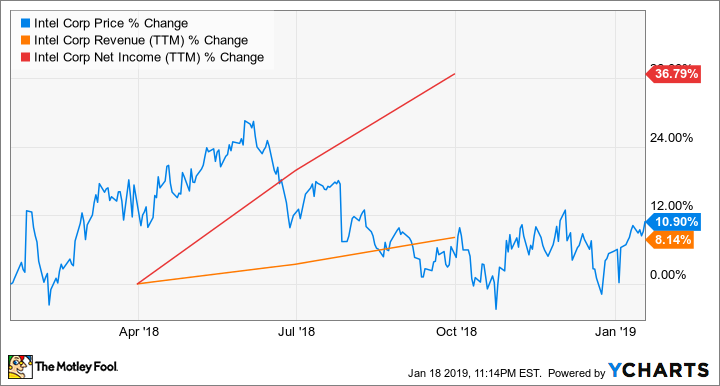Will Investors Like Intel's Earnings Results?
Intel (NASDAQ: INTC) shares have pulled back massively over the past few months thanks to a bunch of headwinds. From production hiccups with existing chips to development delays of its next chip platform, Chipzilla has given investors a lot to worry about. Additionally, the company is under intense pressure from rival Advanced Micro Devices' (NASDAQ: AMD) rapid advancements in processor technology.
All of these problems have caused a loss of confidence in Intel stock even though the chipmaker has been posting solid top- and bottom-line growth. But it will have a chance to turn things around when it releases its fiscal fourth-quarter results on Jan. 24.

Image source: Getty Images.
Solid growth in the cards
Wall Street analysts expect Intel to deliver earnings of $1.22 per share on revenue of $18.99 billion. These numbers are in line with the company's own estimates, and represent double-digit growth over the prior-year period.
As such, Intel shouldn't find it too difficult to meet these estimates, though the data center and the autonomous vehicle businesses could drive stronger-than-expected growth once again. Intel delivered 19% year-over-year revenue growth during the third quarter as the revenue from its Mobileye autonomous driving unit increased 50% annually to a record $191 million.
Mobileye recorded eight new design wins during the third quarter, taking its year-to-date design win total to 20. It won't be surprising to see Mobileye's momentum continue thanks to the announcements Intel made at the recently concluded CES. Meanwhile, Intel's data center business shot up 26% year over year during the third quarter thanks to the growing demand for its server processors for tackling data-intensive artificial intelligence (AI) workloads.
Intel holds a 99% share of the data center server market, and even though AMD is eating into this space, it isn't a big enough player to destroy the company's momentum. So Intel investors can expect another round of impressive growth, though the focus will largely be on what the company has to say about its product road map in light of the emerging competition from smaller rivals.
No need to panic
A lot has been made about the success of AMD's EPYC server processors and how they have the potential to change the company's fortunes. But everyone seems to be forgetting that Intel is still the 800-pound gorilla in the data center market, with a near-monopoly.
AMD's latest announcements at CES have caused a great deal of excitement. The market is looking forward to the new generation of 7-nanometer EPYC chips that will start shipping in mid-2019. Of course, they will be a massive improvement over the 14-nanometer chips that Intel currently sells, but the advantage won't last for long.
Intel announced at CES that it will start shipping competing 10-nanometer Xeon server processors in 2020. It is also developing a new chip based on the 10-nanometer platform, called the Neural Network Processor for Inference, or NNP-I. According to Intel, "[This] new class of chip is dedicated to accelerating inference for companies with high workload demands and is expected to go into production this year."
As such, Intel is attacking data center servers from another angle, and it can defend its current market share against AMD with the help of the Cascade Lake chips that are capable of tacking AI workloads. The tech titan enjoys considerable financial muscle and could easily choose to discount its chips to nip the AMD challenge in the bud until its competing 10-nanometer platform is ready.
Similarly, Intel's 10-nanometer desktop and notebook processors, christened Sunny Cove, are expected to start shipping by the end of the year. So there won't be much of a time advantage for AMD, as its third-gen Ryzen CPUs are expected to hit the market sometime in the middle of 2019.
Intel's tough times shouldn't last for long. Of course, investors have been spooked by the challenges that it is facing, but they need to remember that the company is still delivering impressive double-digit growth and enjoys a dominant position in key markets. Moreover, it is going after emerging tech trends like AI and autonomous cars.
So it won't be surprising to see Intel winning back investor confidence with a solid set of results, setting the stage for a rally.
More From The Motley Fool
Harsh Chauhan has no position in any of the stocks mentioned. The Motley Fool has no position in any of the stocks mentioned. The Motley Fool has a disclosure policy.

 Yahoo Finance
Yahoo Finance 
